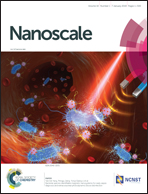An ultra-low frictional interface combining FDTS SAMs with molybdenum disulfide†
Abstract
Interfacial friction is of crucial importance to ensure the friction-reducing and anti-wear properties of mechanical microstructures in micro/nanoelectromechanical systems (MEMS/NEMS). An ultra-low frictional interface combining hydrophobic 1H,1H,2H,2H-perfluorodecyltrichlorosilane (FDTS) self-assembled monolayers (SAMs) coated on an AFM tip with mechanically exfoliated molybdenum disulfide (MoS2) nanosheets deposited on a planar Si/SiO2 substrate was achieved. The FDTS SAMs/MoS2 interface between the FDTS SAMs and the MoS2 nanosheets exhibits an ultra-low friction force that is independent of the relative humidity. The incommensurate contact with ultra-low energy dissipation between FDTS and MoS2 nanosheets and hydrophobic surface properties lead to this ultra-low frictional FDTS SAMs/MoS2 interface. Also, the MoS2 nanosheets have a high elastic modulus, which gives them a smaller contact area than the FDTS SAMs and contributes to the low friction. The excellent hydrophobic properties of both the FDTS SAMs and MoS2 enable them to be unaffected by the relative humidity by preventing the capillary interaction. This study paves the way for extensive applications in reducing the friction of nanoscale contact interfaces.



 Please wait while we load your content...
Please wait while we load your content...